
Asian cities are becoming increasingly vulnerable to climatic hazards (ISET/ISET Nepal, 2008; IDS, 2009). This growing number of climatic hazards is impacting negatively on livelihoods, ecosystems and ecology and is affecting self-adaptive capacities and resilience-building efforts in most parts of Asia. There is an urgent need to harness multi-agency commitments and transparent humanitarian efforts to avoid the vulnerabilities which could arise as a result of climatic disasters, in order to facilitate sustainable development in Asia.
In this context, the Republic of Korea’s (RoK) vision is for a safer Asia. To that end, RoK’s National Emergency Management Agency (NEMA) hosted the Fourth Biennial Ministerial Conference on Disaster Risk Reduction (AMCDRR) in October 2010. The theme of the conference was ‘Disaster Risk Reduction through Climate Change Adaptation’ and it was organised in partnership with United Nations International Strategy for Disaster Reduction (UNISDR), the Global Facility for Disaster Reduction and Recovery of the World Bank (GFDRR) and the Australian Government’s Agency for International Development (AusAID). Prime Ministers, ministers, senior government officials, academics and humanitarian workers from 69 nations gathered in the city of Incheon to agree on a five year strategy for dealing with known and unknown nature-related risks in the countries of Asia and the Pacific. More than 900 delegates participated in the event (NEMA/UNISDR, 2010).
At the Conference, government delegates representing more than 55 countries from Asia and the Pacific approved a five-year Roadmap (‘Incheon REMAP’) and Action Plan to establish climate resilient disaster risk management systems in all countries by 2015 through participatory discussion.
Many international donor agencies and sub-regional agencies are committed to implementing activities in line with the Roadmap and Action Plan. As part of RoK’s contribution to accelerating the delivery of a ‘Safer Asia’ agenda, its National Disaster Management Institute (NDMI), a department of NEMA, has begun hosting international education and training activities for government and non-government agencies from Asia and the Pacific region.
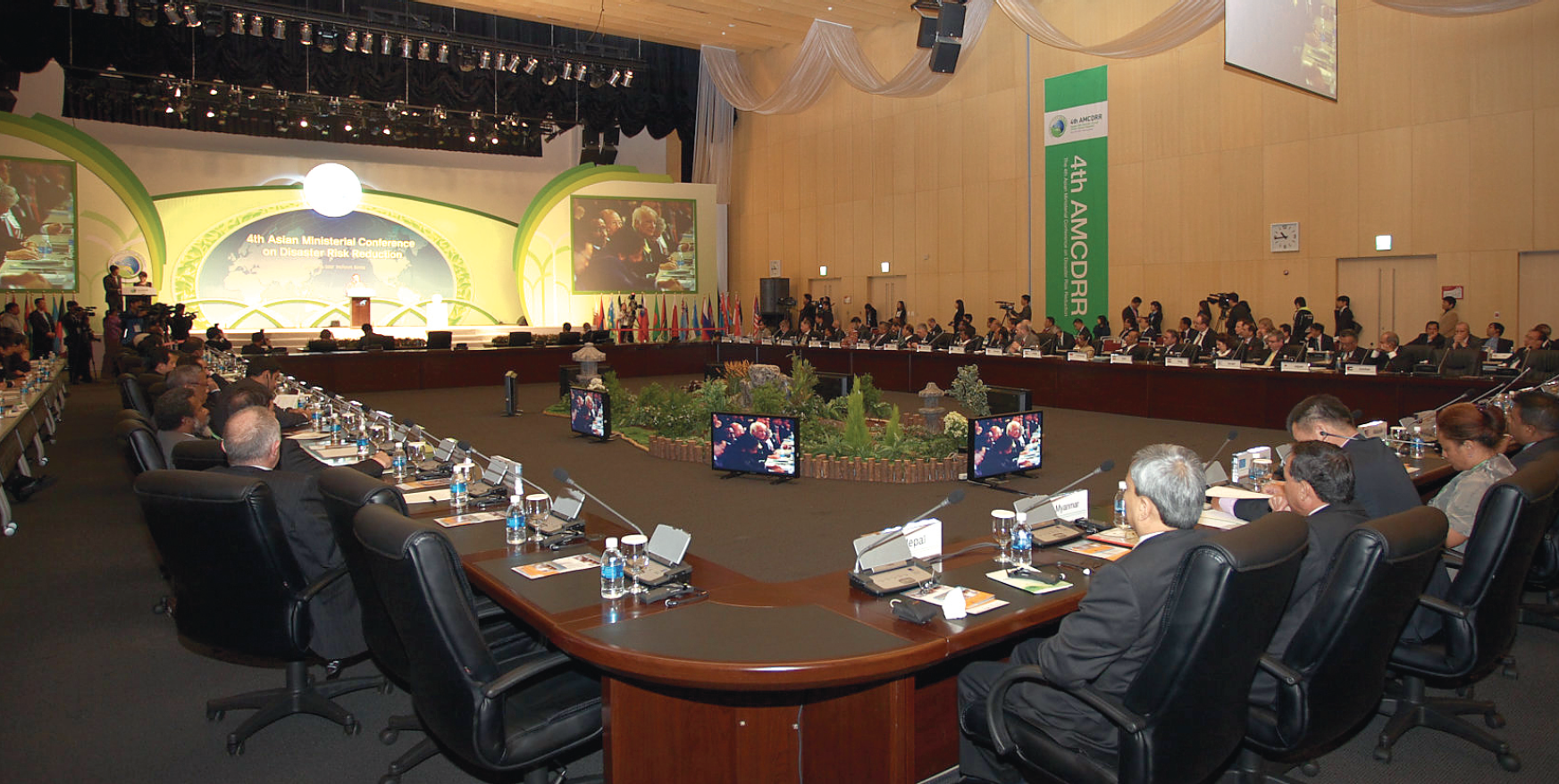
The AMCDRR, Incheon, October 2010.
As in most developed countries, RoK first approached disaster management through the civil defence sector with the establishment of the Central Civil Defence Academy (CCDA) in 1986 by the then Ministry of Home Affairs (MOHA) (NDMI, 2008). The CCDA was then reorganised as the Civil Defence Training Division (CDTD) in April 1994. In May 1997, the Korean Government founded the National Institute for Disaster Prevention (NIDP) to support a research-led training programme to bolster its disaster management capabilities and understanding (NDMI, 2008).
After the events of September 11th 2001, RoK revisited its national emergency management system and in June 2004, NEMA was established to take responsibility for natural disasters and emergency response (MOPAS, 2011). In March 2006, NEMA established the NDMI as a key education and training facility for public bodies and private citizens alike to raise the overall level of disaster preparedness in the RoK. As well as its teaching responsibilities, NDMI also oversees the NIDP which ensures that the latest disaster research findings inform its programmes. The main vision of NDMI is to promote and integrate disaster and safety education in government and non-government communities through interactive learning. To this end, it offers a wide range of training and education courses at the national and international level, and also pursues a research and development agenda with a focus on disaster management policy review, the production of teaching materials and technological development (NDMI, 2008). Given NEMA’s mandate for emergency response and disaster management, the Institute concentrates on both natural disaster awareness and civil defence protection requirements.
This paper reports on a recent visit to the National Disaster Management Institute’s complex located near the western city of Cheonan. The purpose of the visit was to get a flavour of the work being performed by NDMI in light of the Korean government’s AMCDRR commitment to fostering both national and international disaster resilience.
The Institute is situated in the countryside around fifteen minutes’ drive from Cheonan. Cheonan is just over an hour’s train ride from Seoul and can be reached by train from the furthest parts of the country within 4 hours. Set against a verdant green hillside, NDMI shares its campus with the National Fire Service Academy. Together they host an extensive spread of facilities within their 26 hectare site. A tree-lined driveway leads to the large main building, which has a vista back across the hillside and over the centre’s playing fields. Set back into the rising ground behind the main frontage are guest dormitories, a canteen-style dining room, a patio area and numerous training buildings. Further down the hill, the practical training facilities are located including NDMI’s Safety Experience Centre, the Fire Academy’s outdoor activity and practice areas, a large sports complex for the use of trainees and a conference centre with a capacity of over a hundred.
The Institute is home to the Planning and Cooperation and Education and Operation Divisions of the NDMI, with the NIDP managing the Disaster Research and Management Divisions in offices in Seoul. The focus at the campus is very much on training and learning, with five resident professors handling a full time schedule of teaching and course development.
The Planning and Cooperation Division is responsible for supporting and managing the operation of the Institute and its general affairs, as well as overseeing the online learning courses the Institute offers and the international education programmes and their funding.
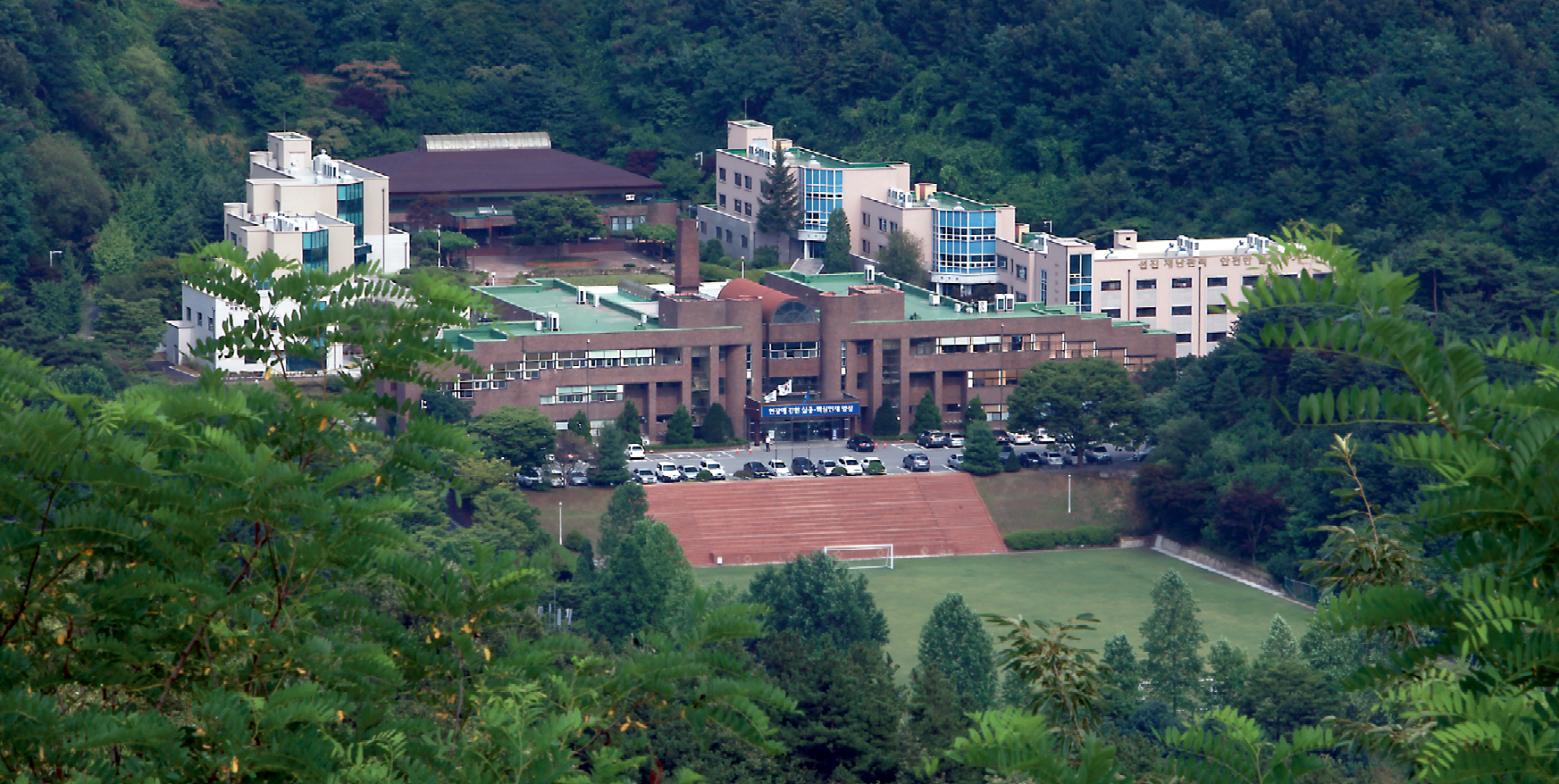
The NDMI and National Fire Service Academy campus.
The Education and Operation Division is responsible for national courses, including programme design and advertisement, and for education planning and the development of training techniques.
As well as offices for these divisions, the main building houses an impressive array of modern and well equipped lecture theatres and classrooms for delivering the theoretical components of the courses. Each room is furnished with a computer linked projector, variable lighting for teaching purposes, ergonomic chairs and plenty of desk space for each trainee. Some of the larger theatres are tiered to provide maximum viewing potential. Typical classrooms hold around 40 trainees, but the larger lecture theatres can comfortably accommodate 120. It is evident that considerable care has been taken to provide an environment that encourages learning: the classrooms are contemporary and provide a professional atmosphere for educating.
For those seeking further knowledge, an exhibition of emergency defence equipment has been set up in the foyer of the main building, complete with a comprehensive written commentary on usage and deployment of the apparatus.
A separate structure behind the main building houses the National Disaster Management System (NDMS) Information Centre. Another impressively equipped facility, its purpose is to provide training for all government officials on the procedures and operation of the System so that they gain an understanding of how NEMA’s Disaster Status Control Centre (based in the central government complex in Seoul) processes the information it receives from reporting authorities when a disaster occurs.
The two classrooms in the NDMS centre each have positions for up to 76 trainees, each station furnished with a computer to allow trainees to follow and trial the information processing techniques and procedures taught on the courses.
The training is mandatory for local government officials who are responsible for operating the System in their district. The overall aim is that officials come away equipped with the knowledge of how to report disaster information correctly to NEMA’s Control Centre using the System’s procedures in the event of a hazard occurring. NDMS training is a component of several of the NDMI courses and approximately 1000 government officials have been trained to date (NDMI, 2011). The RoK’s NDMS is considered successful and has been exported for use in several countries including Indonesia and Paraguay.
The NDMS building also houses eight discussion rooms designed specifically for group work exercises, which form an essential component of all of the courses that NDMI runs. As with the teaching rooms in the main building, each room is well equipped and appealing to those who want to learn, with a large whiteboard for brainstorming ideas, a computer terminal and a conference style table to facilitate group working and the preparation of presentations. This style of learning is encouraged by NDMI to allow trainees to demonstrate and consolidate what they have learned, and often an element of competition is introduced to the group work portion of the classes to encourage high standards.
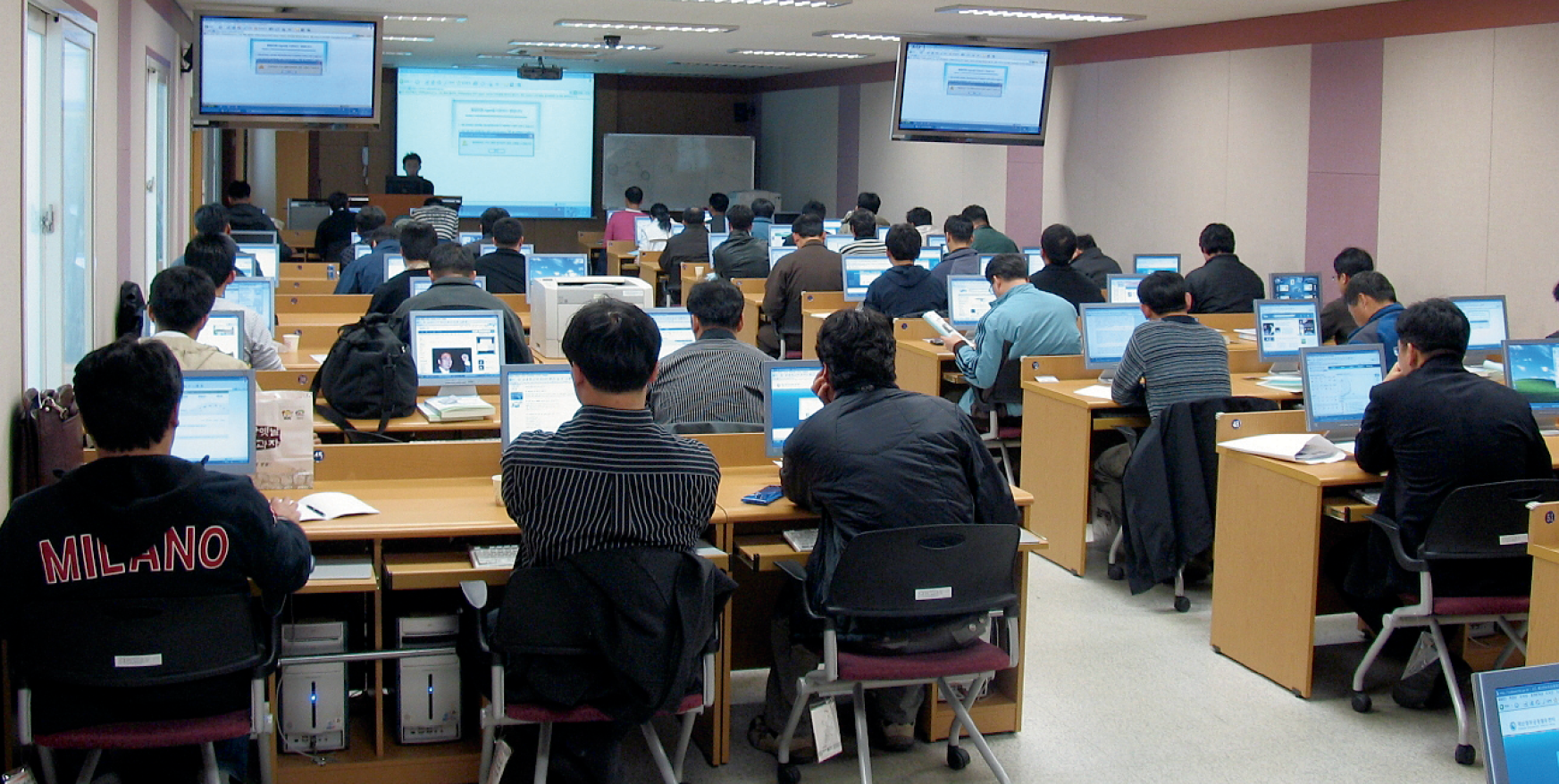
A classroom in the NDMS Information Centre.
Opposite the NDMS building is the Disaster Information Centre which was built in 2006 as an additional information source for trainees on previous disasters in the RoK. It is designed with interactive features for all ages, including touch screen monitors, a small movie theatre and a reference library. Although this facility is still under development, it represents another dimension of the Institute’s focus on learning and information sharing.
The appropriately named Safety Experience Centre (SEC) is a short walk down the hill from the main complex. This is where the practical training classes occur on-site. This light and airy facility houses classrooms for the introduction of the practical subject areas and innovative Experience Areas for applied teaching activities (Figure 1).
Figure 1. Activity areas at the Safety Experience Centre.
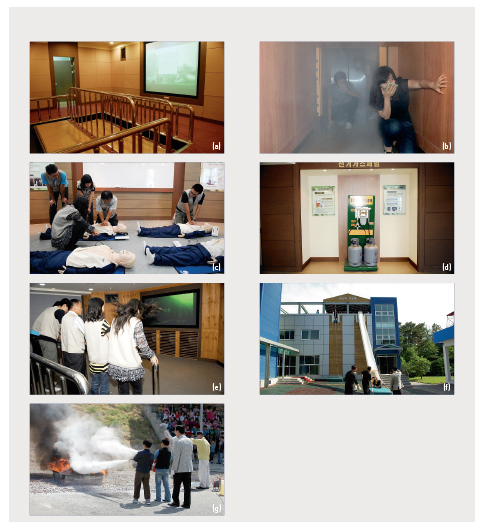
(a) The Earthquake Experience Room, where trainees stand on a movable plate, hold on to a waist-high railing and watch a video detailing the extent of damage and destruction associated with each rising measurement on the Richter scale, whilst simultaneously experiencing the associated magnitude of the quake through the movement of the plate.
(b) The Smoke Experience Room, which is actually a series of corridors and obstacles that trainees must negotiate in pitch darkness whilst imitation smoke is pumped into the space.
(c) Life Emergency Experience Room, equipped with dolls for teaching CPR and other first aid measures.
(d) The Electricity and Gas Experience Room for training on how to use these energy sources safely and how to act during a gas or electricity emergency.
(e) The Wind Tunnel, where wind speeds of up to 30m/s can be experienced.
(f) The Air Safety Mat, Descending Lifeline and Relief Tunnel Experience Tower located in the outdoor courtyard to give practical experience of evacuation measures which may be used for high buildings. Trainees are given a practical demonstration and then helped to complete the activities themselves.
(g) The Fire Pit, located in the side courtyard, for demonstrating and practising the use of fire extinguishers.
Source: NDMI (2008)
The outdoor areas at the SEC are complemented by covered tiered seating stands for open air demonstrations and teaching. Unsurprisingly, the SEC is reportedly particularly popular with school groups.
The Institute also has a number of off-site locations for demonstrating examples of natural hazard management schemes. The Coastal Erosion Management Facility is a site in Busan city where the local government has extended the beach away from the built form edge so that coastal zones are protected from tidal surges. Classes at this site include discussion of various approaches to preventing and managing coastal erosion issues. The Landslide and Slope Hazard Prevention Facility is a site near the cities of Gumi and Busan where several construction methods and other practices have been implemented to prevent landslip from occurring, including the positioning of seismic sensors inside the hills to provide a ground instability early warning system for residents living in the area.
All in all, it is an impressive set up. The attractive location and well-presented grounds aside, the facilities available to the teaching staff are wide-ranging and allow for coverage of a considerable array of topics related to disaster and emergency management, as can be seen from the types of programmes offered.
The Institute’s academic year starts in late February/early March, with the first semester finishing in late July and the second semester running from early September to December. This academic year the Institute is offering 82 different types of course. Some courses are repeated throughout the year, resulting in a total of 325 courses scheduled to run this year for 16,110 trainees.
Given the AMCDRR’s resolution to build not only institutional but also community resilience, the NDMI runs courses for both government officials and employees and also civilians and community groups. Course length ranges from occasional intensive courses of 8 weeks for specialists that include field trips and training abroad, to five day sessions for government workers; and two day classes for citizens.
The courses are differentiated into five types: civil defense; natural disaster management; civilian education; online; and international. Some of the courses offered are detailed in Figure 2 below.
Community groups are able to get involved in NDMI training through membership with the Community Emergency Response Team (CERT) system. Each local government authority has a CERT unit which is responsible for contacting and networking with community leaders, community groups and local volunteer organisations. Through membership with a local CERT unit, these groups are able to apply to attend the Citizen Training course. The local government pays for their bed and board at the centre and, as the Institute is a public body, the training is free. NDMI runs a specific programme for citizens that is tailored to provide education on the hazard types they are most likely to experience.
School groups of all ages are also welcome at the NDMI. The NDMI website provides a portal for schools to apply for places (up to 20 per group) for a safety experience course. This is a largely practical course for students aimed at raising awareness and familiarity of how to act during an emergency. Courses for teachers and school officials are also run during the school vacation period so that schools are able to integrate disaster education into their curriculum for students.
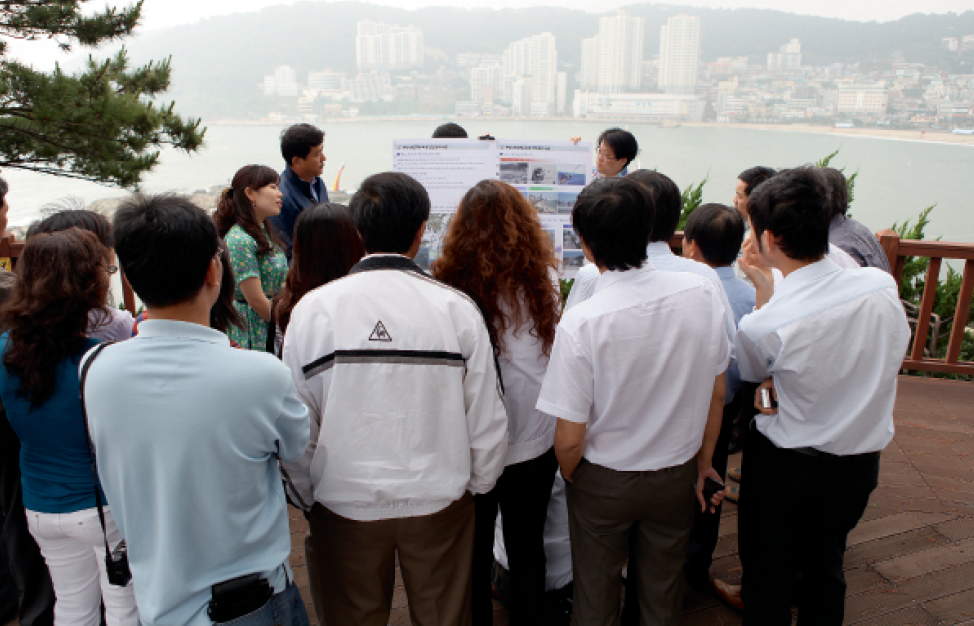
The Vietnamese delegation on a field trip.
The main aim of the civilian courses is to familiarise members of the public with the activities and procedures which they may encounter in a real crisis situation, the benefits of which are almost indefinable for community members and emergency responders alike: experiencing a safety mat jump even once in a controlled environment will undoubtedly make a jump in an actual emergency somewhat less overwhelming, if no less daunting.
Of course, the Institute also plays an important role in providing training for government officials at all levels from various Ministries and departments on a variety of subject areas depending on their requirements. Depending on their position, officials are required to obtain a certain number of course credits from NDMI programmes as part of their professional development. Every October, the Education and Operation Division issues information packs and posts on its website the coming year’s course schedule so that local governments can choose which to enrol on. The local government authority pays for bed and board whilst its employees are at the centre and the training is free.
The variety of courses the Institute offers is impressive. Courses are tailored to the seniority and existing knowledge levels of those attending, so that all are catered for according to their needs. The staff-members of the Institute are committed to providing a high standard of educational experience for those that visit and were openly enthusiastic in describing the work which the Institute is doing.
As may be expected, quality control is also viewed as very important. Course material and trainee feedback are assessed annually by the Education and Operations Division and the resident professors so that courses can be assessed for quality and revised where necessary.
Whilst NDMI and the Fire Academy run their courses separately, their location on the same campus means that specialists from both departments are available to teach seminars or practical sessions to groups whenever necessary. Similarly, external specialists and guest lecturers are commissioned to teach elements of some courses to provide a high standard of education. This broadens the range of expertise and learning opportunities for those attending courses at either centre.
Despite the expansive array of course types and training facilities already offered by the Institute, NDMI is striving for more. It is trying to create a legally mandated, nationally coordinated volunteer civil defence association to oversee the existing regional volunteer corps. It hopes to eventually reach a force of 30,000 members and NDMI has made a budget request for funding to train 15,000 civilian volunteers in the next academic year. It is also championing a proposed national law that will require that officials charged with emergency response duties to come to the centre at Cheonan for additional training in core aspects. The purpose is to ensure that they are training to the highest level.
Research and development achievements are also important to the NDMI and recent achievements include the development of automated technologies for disaster damage assessment and mountain watershed run-off control. In addition, NDMI is identifying criteria for establishing a high-performance integrated spill control strategy (NDMI, 2008).
NDMI has been hosting international courses since 2008. Each July, NMDI submits a proposal for international courses on a variety of topics to the Korea International Cooperation Agency (KOICA). KOICA decides which courses to fund based on the priorities for international aid set out by Central Government. KOICA typically funds about three international courses per year and once these are confirmed in annual budgets, KOICA distributes the proposed course material to countries identified for funding who are able to choose programmes which focus on their specific needs.
For the period 2011-2013, NDMI has organised a KOICA-funded Climate Change Adaptation (CCA) training programme for government and non-government officials, including journalists, from eight SAARC (South Asian Association for Regional Cooperation) countries: Afghanistan, Bangladesh, Bhutan, India, The Maldives, Nepal, Pakistan, and Sri Lanka*. A total of sixty participants will be trained at the Institute over the course of the three year programme.

Visiting the Meteorological Office.
The international component of the Institute’s programme is perhaps the most important for fulfilling Korea’s Safer Asia aspiration: NDMI’s persistence with its international programmes despite funding limitations is evidence of Korea’s commitment to this policy.
Figure 2. A selection of the courses offered by NDMI.
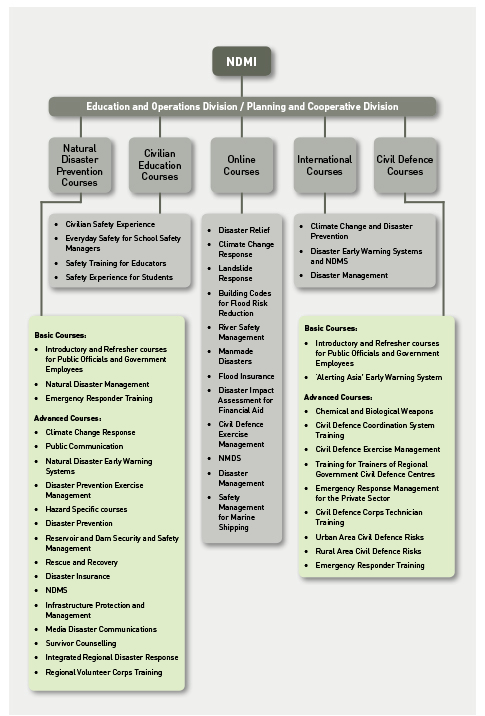
Although funding has historically come from KOICA, recently other international agencies have expressed an interest in funding courses for Asian countries at NDMI. A recent example is an eight day training programme on Integrated Disaster Risk Reduction and Climate Change Adaptation organised for officials from the Government of Vietnam, jointly funded by the World Bank (Vietnam) and NDMI. The programme was held between 20th – 27th June 2011. The main objective of the training was to distribute evidence-based knowledge sharing in the subject area. Experts and professors from NDMI introduced various DRR and CCA related topics such as:
In terms of the Republic of Korea’s commitment to disaster resilience-building, the NDMI is testament to its resolve to improve not only institutional knowledge at the government level, but also community awareness and response capacity. Its international programme clearly shows a genuine willingness to assist with the development of resilience in other countries in Asia and as such it should be praised for its efforts in this sector, in line with the objectives of the Incheon Roadmap and Action Plan.
The setup at the NDMI lends itself to those looking to obtain disaster management education from a comprehensive facility run by a dedicated team of professionals that is easily accessible to those flying into Seoul. However, at present it is a resource that perhaps the rest of Asia does not know enough about. With greater priority given to the disaster risk reduction agenda at the governmental and international donor level, the potential which the NDMI offers for risk reduction to the international community could be maximised to the advantage of all.
* Interested parties from SAARC countries are advised to contact their local KOICA office or the Republic of Korea embassy.
The authors would like to extend special thanks to Mr. Si-Oo Nam, Director of the Planning and Cooperation Division Mr. Eung-Beom Lee, Senior Deputy Director of the Education and Operations Division; Mr. Kwang-Seok Kim, Deputy Director of the Education and Operations Division; and Miss. Misook Kim, Coordinator of International Disaster Management Courses, Planning and Cooperation Division for their time and the support provided in the writing of this article. Thanks go to all at the NDMI who contributed to our experience at the centre.
ISET/ISET Nepal (2008) From Research to Capacity, Policy and Action: Enabling Adaptation to Climate Change for Poor Populations in Asia through Research, Capacity Building and Innovation. Kathmandu, Nepal.
Institute of Development Studies (IDS) (2009) Urban Governance for Adaptation: Assessing Climate Change Resilience in Ten Asian Cities. IDS: University of Sussex, UK
Ministry of Public Administration and Safety (MOPAS) (2011). History of MOPAS. Accessed from the World Wide Web: http://www.mopas.go.kr/gpms/view/english/about/about05.jsp
National Emergency Management Agency and United Nation International Strategies for Disaster Reduction (NEMA/UNISDR) (2010) Incheon Road Map and Action Plan on Disaster Risk Reduction (DRR) through Climate Change Adaptation (CCA). The Fourth Asian Ministerial Conference Task Force, National Emergency Management Agency: Seoul, Republic of Korea
NDMI (2008) The Center for Educating World–leading Experts in Disaster Management. National Disaster Management Institute: Cheonan, Republic of Korea
NDMI (2011) 2011 Training Schedule. National Disaster Management Institute: Cheonan, Republic of Korea
Olivia Dobson is an Affiliate of the Disaster and Development Centre of the Department of Geography and Environmental Management, Northumbria University and a visiting researcher at the GRS Lab, Yonsei University, Republic of Korea. She is studying for her Master of Science degree in Disaster Management and Sustainable Development from the School of the Built and Natural Environment at Northumbria University, UK.
Komal Raj Aryal is a research associate in the Department of Geography and Environmental Management of the School of the Built and Natural Environment at Northumbria University, UK. He is a visiting research fellow at the GRS Lab, Yonsei University, Republic of Korea and research coordinator of the Northeast Asia and UK study programme on risk reduction, adaptation and safety. In 2010, Komal worked for the fourth Asian Ministerial Conference Task Force of National Emergency Management Agency (NEMA), the Republic of Korea.
The authors can be contacted at: olivia.dobson@northumbria.ac.uk and K.aryal@northumbria.ac.uk